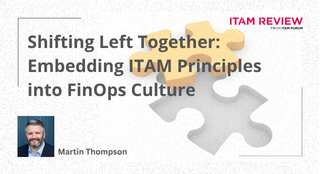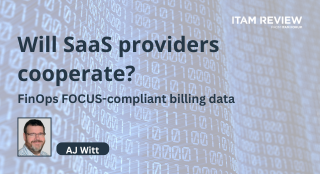How much of a focus should software audits be for an ITAM manager in 2020 and beyond? Part 1.

With reports that software audits are slowing down and the increasing move to cloud within many organisations, does that mean software audits are not important anymore?
Ahead of our Wisdom USA conference, we asked our sponsors to share their thoughts on the importance of audits going into the 2020s and beyond. We had such great responses that this is only part 1! Part 2 will follow on Thursday.
Elée / Sambox.io
We believe the major added value of an ITAM Manager today is not to spend time managing audits but rather they should be geared towards strategic moves such Open Source and Cloud management.
However, can we really afford not to pay attention to software audits in 2020? Unfortunately, audits will remain time-consuming for 2 main reasons:
1) Audit frequency has not decreased. Every year, we hope for it, but software publishers have difficulties giving up such easy revenue streams; we may notice slight changes with IBM launching IASP for instance, but big vendors seem likely to stick to the same audit recipe.
2) IT is alive. Infrastructure keeps on evolving, vendors release new licensing rules with new restrictions – compliance positions established just one year ago can already be obsolete.
While audits will remain for the foreseeable future, ITAM managers should look to automation & SAM tools.
This will help transform compliance positions into commodities, but still with a high level of accuracy & performance…and once audits are no longer profitable for vendors, the balance of power will be reversed.
Snow
Software audits should continue to be a focus area for IT Asset Managers, but audits should not be the primary focus as they have been in the past. While some believed the shift to cloud and changes in audit practices by Microsoft and Adobe would kill the audit, data shows vendor audits are still common.
A 2019 study conducted by Snow Software and IDG1 identified that 73% of organizations surveyed had been audited by at least one vendor in the past year. Of those organizations surveyed, 42% of IT leaders stated the shift of IT spend to business units had led to audit preparation becoming more time consuming and complex. With this degree of audit activity, it would be risky for any IT Asset Manager to currently shift focus dramatically away from audit management.
However, while ITAM leaders must continue to monitor audit risk- their focus should expand to include cloud management. According to Gartner2, 28% of Software Asset Management tool purchases are now driven primarily by cloud. In our engagements with customers, we have found that most organizations are overspending in the cloud. We find that many companies are realizing that the benefits of cloud – ease of deployment, scalability, and consumption pricing – are also what makes cloud incredibly difficult to manage.
With cloud, end-users do not require IT to set up applications for them and additional licenses can be purchased via credit card without any input from procurement or ITAM professionals. Given the need for organizations to move faster – to be more agile – few guardrails have been put in place to reign in cloud sprawl. Companies not actively managing their cloud consumption using ITAM governance are wasting large amounts of money and introducing unnecessary risk to the organization.
In 2020, the role of the IT Asset Manager is harder than ever before. Data is everywhere, on-premises and in multiple cloud environments. Now more than ever before, organizations need ITAM professionals to help them integrate cloud data into ITAM practices and tools. This integration will help their organizations see the complete technology landscape and provide the necessary technology intelligence to drive effective cost and risk mitigation programs across on-premises and cloud environments. Progress in this area cannot be done without ITAM leaders keeping a foot in both the audit and cloud worlds.
1. Snow Software and IDG, “How decentralized IT spending is impacting IT”. 2019.
2. Gartner, Managing Software Assets in a Cloudy World. 2019.
License Dashboard
by Sean Robinson

Ensuring an organisation is prepared in the event of a vendor audit has, historically, been the main driver for implementing a Software Asset Management (SAM) process. License Dashboard’s 2020 ITAM Community Survey found that despite the perceived decrease in auditing activity, 59% of respondents had still received an audit request in the last two years, and 36% had received an audit request in the last twelve months – proving that auditing is still very much around.
In the UK especially, major vendors such as Microsoft have reduced their auditing activity, but clearly these providers are still required to protect their Intellectual Property, so they continue to work with third party companies to review customer sites.
As technology rapidly evolves and new license complexities emerge, optimisation and cost savings have become a critical business objective for all organisations The cost saving benefits of Software Asset Management alone are enormous and businesses should certainly ensure they are taking advantage of the savings and efficiencies to be found, but we believe at License Dashboard that you cannot achieve these aspirations without having an underlying audit-centric approach in the first place. It is only by having full visibility and understanding your software deployments, usage and entitlements across your desktop, cloud, mobile and data centre environments that you can begin to make recommendations for cost savings.
We recommend that a clear SAM process be in place and regular reviews of all entitlement and installed data should be standard practice; this ensures organisations are accurately reflecting their consumption data. Inaccuracy when collecting data, or not seeing the full picture of software installs, was the biggest challenge indicated by respondents to our 2020 ITAM Community Survey. Being prepared for these shortfalls will ensure your organisation has the upper hand when it comes to contract renewals, saving potentially hundreds of thousands of pounds whilst remaining compliant.
Reviews of your IT data will ensure you are in the best position to upgrade your software while remaining compliant and within budget. Having an audit-centric approach to your Software Asset Management strategy will help you reach your digital transformation goals as well as remain ready for when a vendor audit request inevitably arrives.
For 2020 and beyond, audits should always be a focus of your SAM strategy as without the basics in place you cannot reach your full SAM potential.
Conclusion
It seems clear that software audits are going to be around for the foreseeable future but also that an ITAM Manager’s focus must shift. While audits must be dealt with when they occur, working towards automation of many tasks can free up ITAM professionals for the new challenge – managing the cloud. It will be a balancing act for us all – making sure you don’t allow cloud spend to run wild by focusing too much on-premises…but also recognising that “traditional” non-compliance can still lead to significant unexpected spend and must continue to be managed accordingly.
If there is a drop in vendor audits occurring, it certainly isn’t enough to offset the increased ITAM workload brought about by the cloud! Now could be the time to look at whether you need extra people in the ITAM team to ensure you can continue to deliver the same high standards across both the existing and emerging software landscapes.
Can’t find what you’re looking for?
More from ITAM News & Analysis
-
Broadcom vs Siemens AG - A Brewing Storm
The ongoing legal battle between VMware (under Broadcom ownership) and Siemens is yet another example of why ITAM goes far beyond license compliance and SAM. What might, at first glance, appear to be a licensing dispute, ... -
Shifting Left Together: Embedding ITAM into FinOps Culture
During one of the keynotes at the FinOps X conference in San Diego, JR Storment, Executive Director of the FinOps Foundation, interviewed a senior executive from Salesforce. They discussed the idea of combining the roles of ... -
Addressing the SaaS Data Gap in FinOps FOCUS 2.1
I recently reported on the FinOps Foundation’s inclusion of SaaS and Datacenter in its expanded Cloud+ scope. At that time, I highlighted concerns about getting the myriad SaaS companies to supply FOCUS-compliant billing data. A couple ...
Podcast
ITAM training
Similar Posts
-
Broadcom vs Siemens AG - A Brewing Storm
The ongoing legal battle between VMware (under Broadcom ownership) and Siemens is yet another example of why ITAM goes far beyond license compliance and SAM. What might, at first glance, appear to be a licensing dispute, ... -
Shifting Left Together: Embedding ITAM into FinOps Culture
During one of the keynotes at the FinOps X conference in San Diego, JR Storment, Executive Director of the FinOps Foundation, interviewed a senior executive from Salesforce. They discussed the idea of combining the roles of ... -
Addressing the SaaS Data Gap in FinOps FOCUS 2.1
I recently reported on the FinOps Foundation’s inclusion of SaaS and Datacenter in its expanded Cloud+ scope. At that time, I highlighted concerns about getting the myriad SaaS companies to supply FOCUS-compliant billing data. A couple ... -
The Future of ITAM
As an ITAM Industry Analyst, I’m often asked what ITAM’s future looks like. This can be a tough question to answer because when it comes to the future, there are endless possibilities. Often, it seems, some ...






